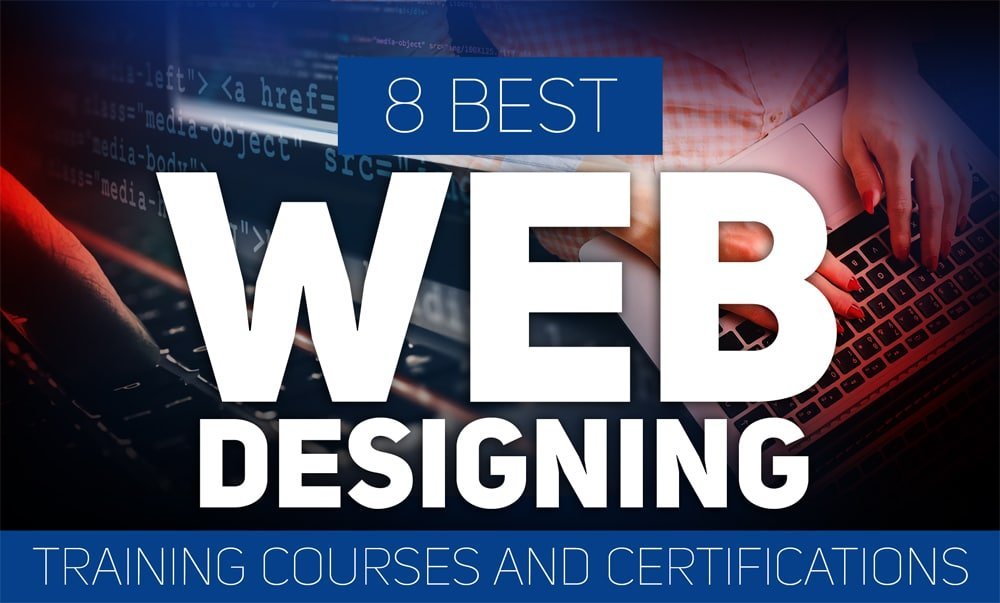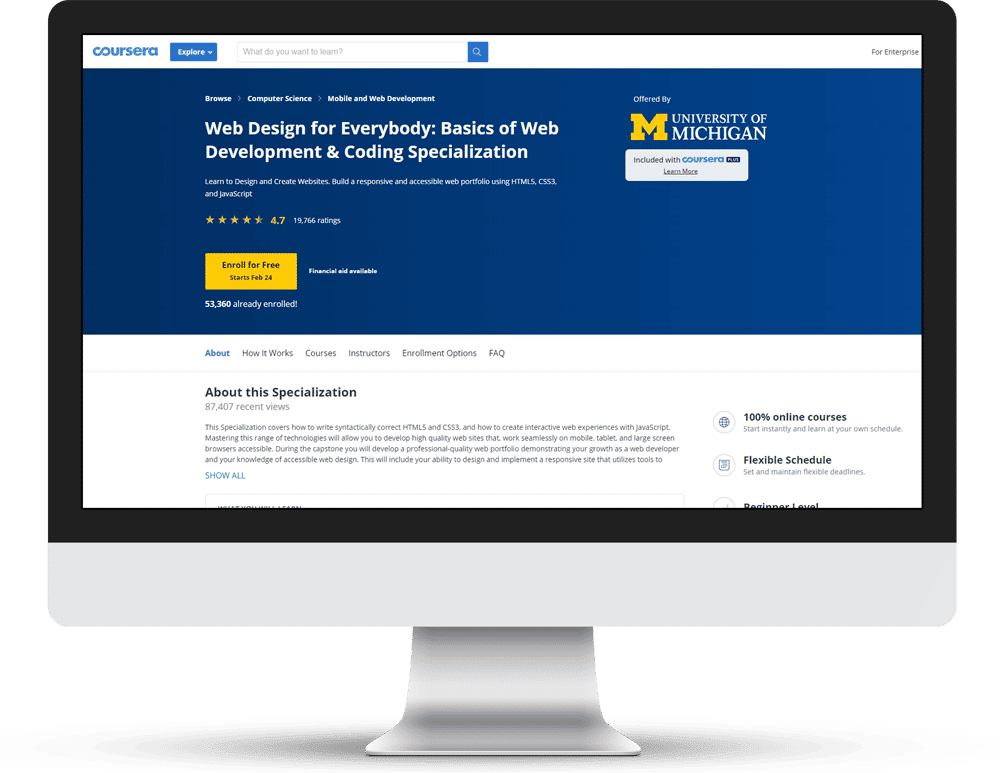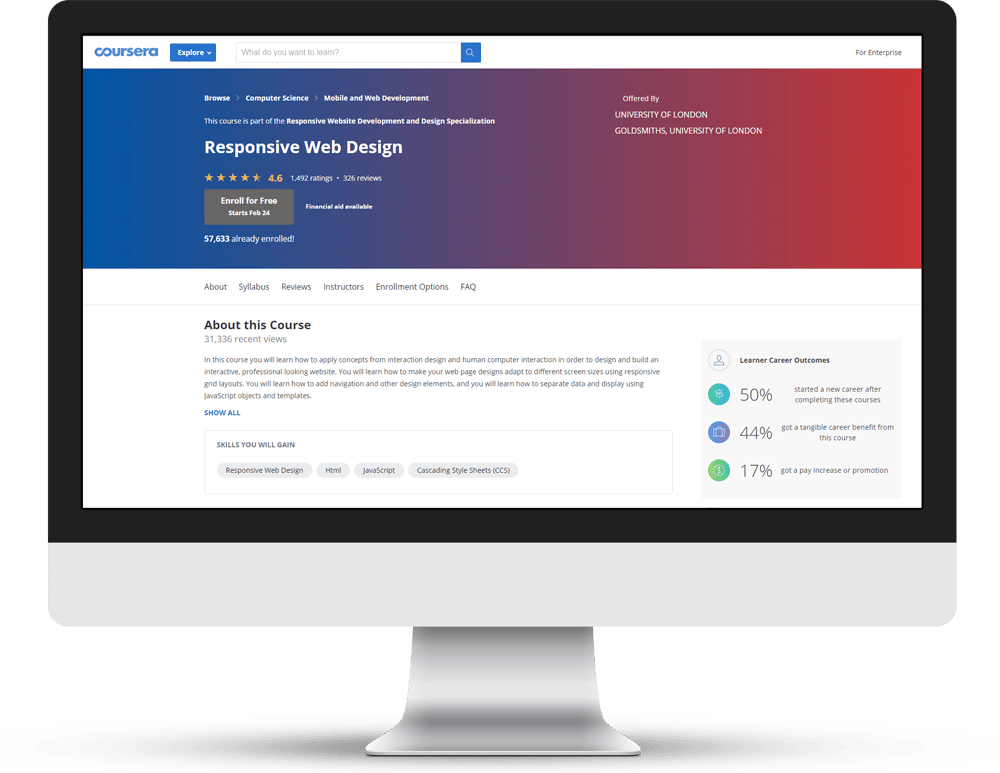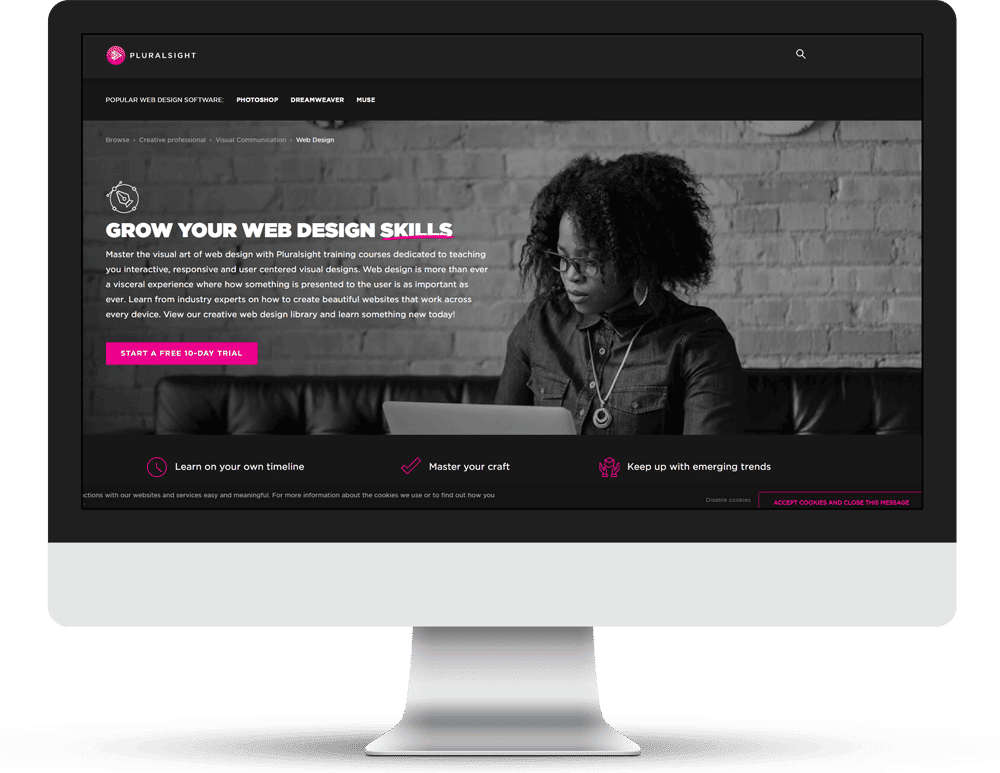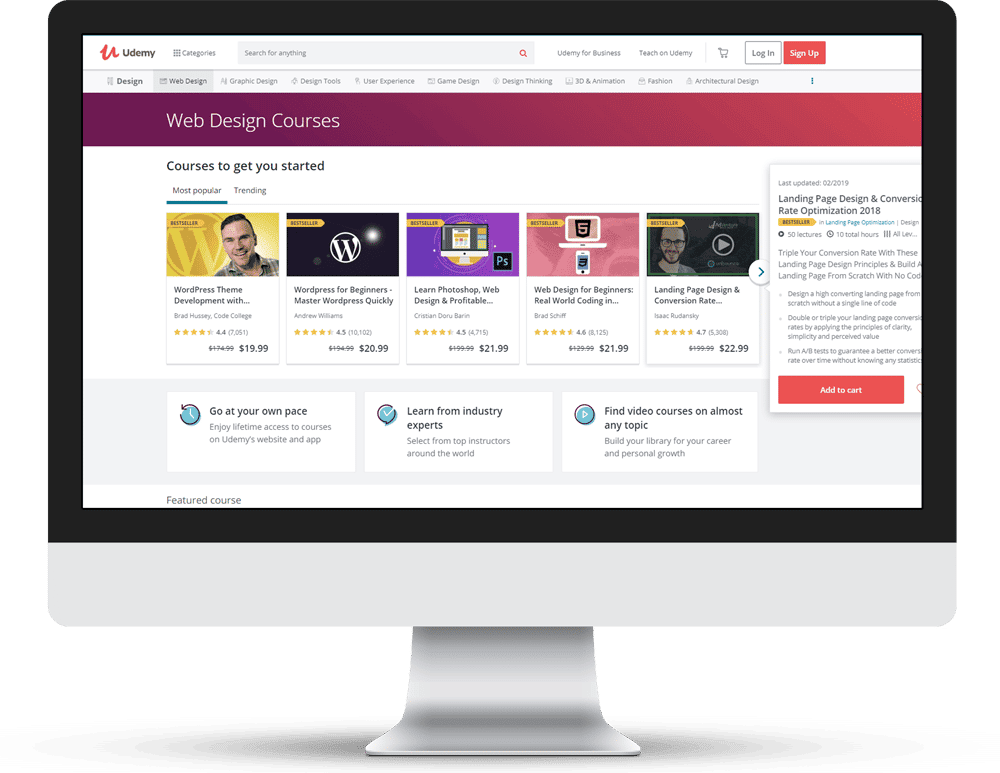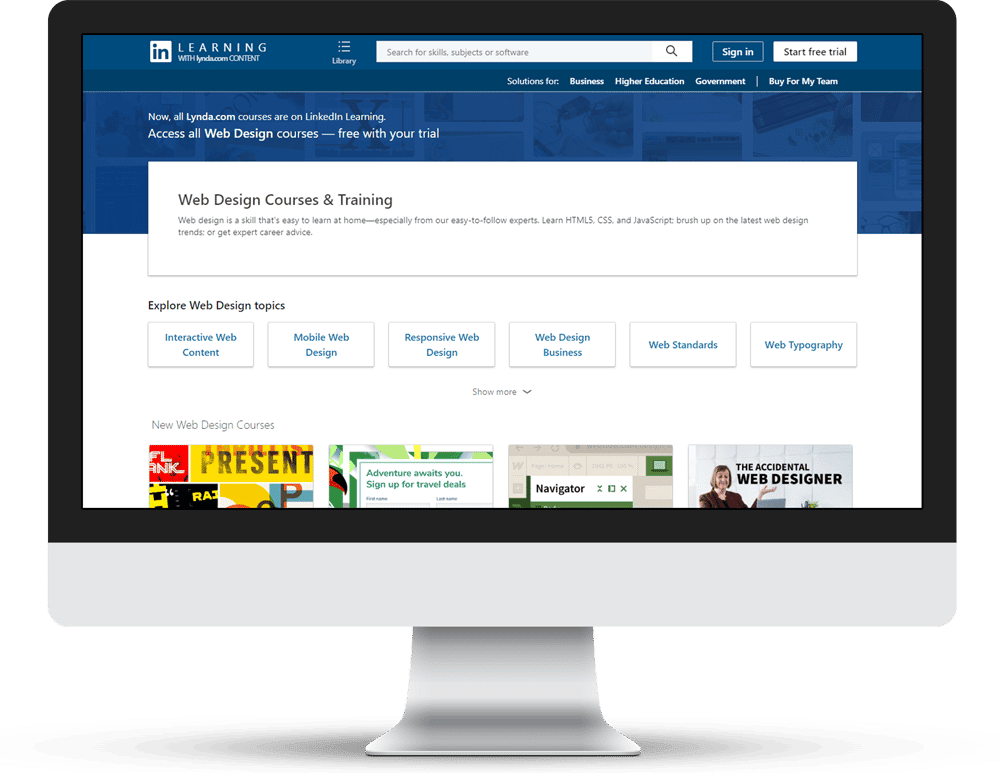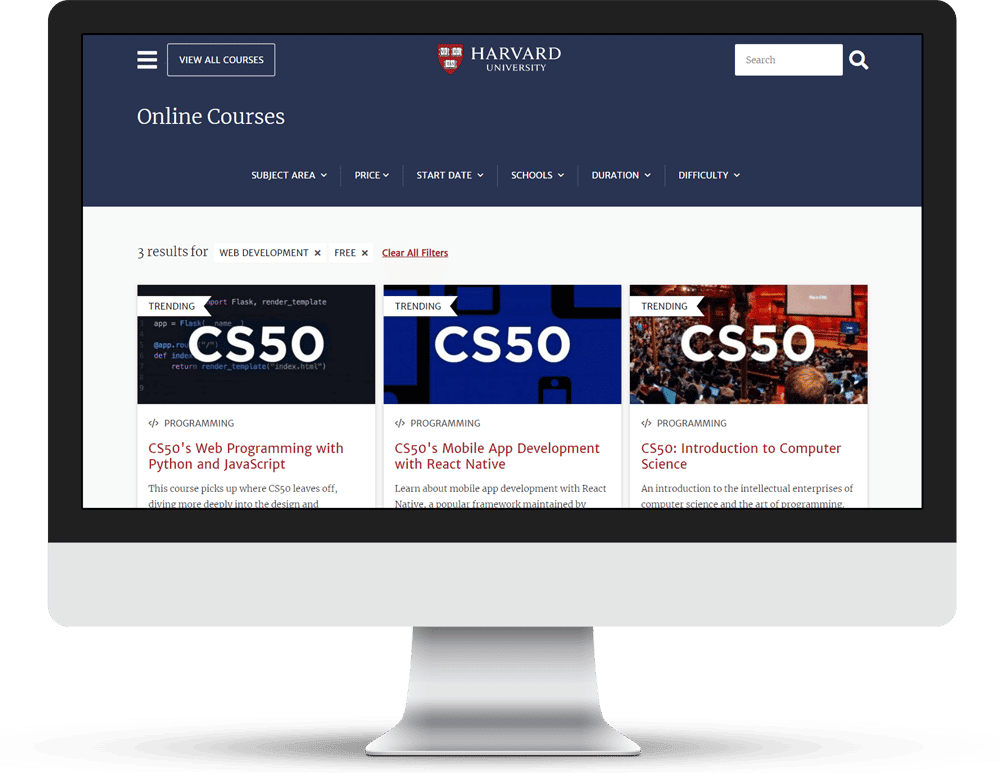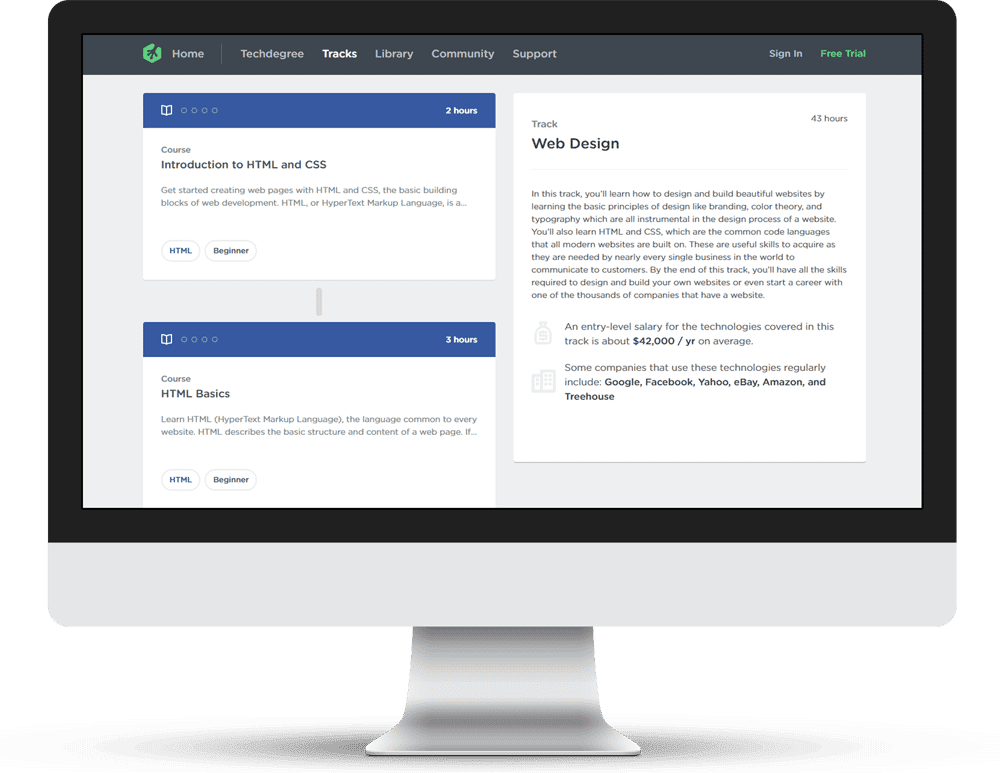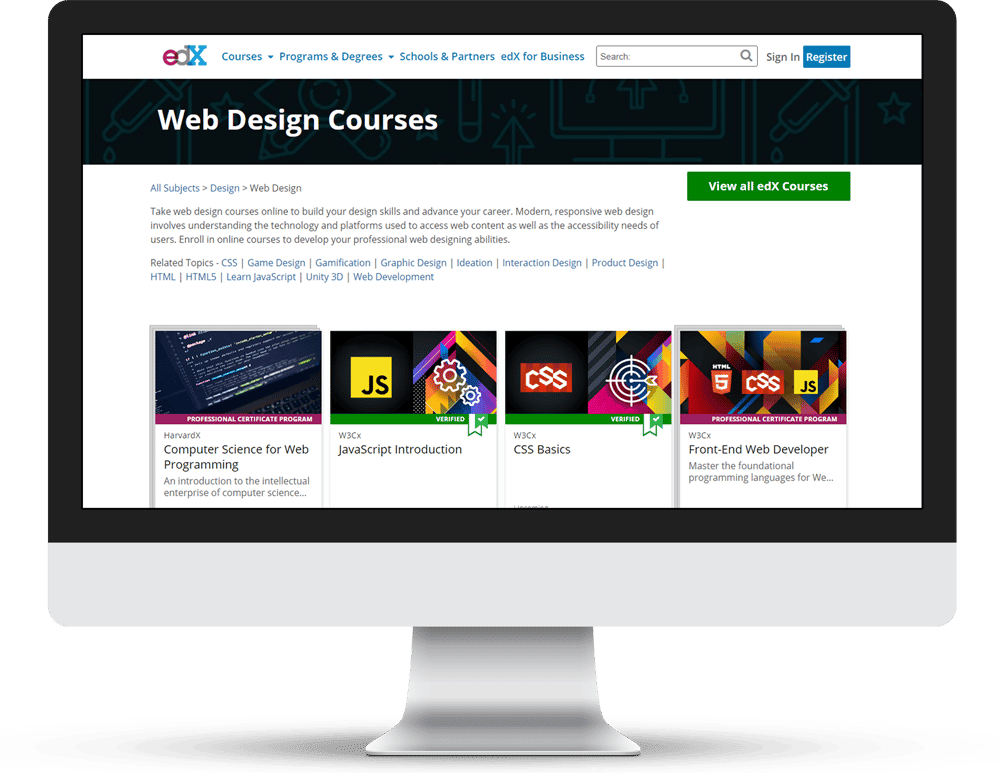Web design is a rapidly evolving field within the IT landscape, influenced by emerging technologies, shifting design trends, and changing user expectations. With over 1.8 billion websites online today, the demand for skilled web designers is greater than ever. Staying updated with the latest skills is crucial for both current professionals and aspiring designers to maintain relevance and advance their careers. Engaging in web design training courses that provide current knowledge and practical experience is a vital step in this journey.
In this post, we’ve curated a list of the 8 best web design training courses and certifications available, detailing their features, ratings, and enrollment numbers to help you choose the right fit for your needs. Whether you’re looking for free resources or are ready to invest in your education, this guide offers options that cater to various skill levels and learning preferences. With the right training, you can enhance your proficiency in essential skills like HTML, CSS, and JavaScript, positioning yourself for success in a field that is projected to grow by 13% from 2020 to 2030.

Key Takeaways
- Stay Relevant: Continuous learning is essential to keep up with the dynamic nature of web design, especially as 80% of employers prefer candidates with recent training.
- Variety of Options: The list includes both free and paid courses, allowing you to choose based on your budget and learning style; for example, 40% of online learners prefer free resources.
- Comprehensive Features: Each course includes detailed features and benefits, including user ratings (averaging 4.5 out of 5) and enrollment statistics, which help you make an informed decision.
- Skill Development: The courses cover essential skills, including HTML, CSS, JavaScript, and responsive design, equipping you with the tools necessary for today’s web development landscape.
- Flexibility in Learning: Many courses offer self-paced learning options, making it easier to fit education into your busy schedule, which is a key factor for 70% of adult learners.
8 Best Web Designing Training Courses and Certifications
1. Coursera Web Design for Everybody Certification
While collaborating with Coursera, the University of Michigan brings you an in-depth course to help you get expert web design skills. The course intends to prepare you to master skills in designing and creating websites. Skills to learn include building a responsive as well as accessible web portfolio while utilizing HTML5, JavaScript, and CSS3. The 4.7 out of 5 rated course has so far equipped over 52,600 learners with these critical skills. You’ll be studying through a series of five courses that include a capstone at the end. Students would be taken through web development basics as well as coding.
Mastering coding in CSS3 and HTML and knowing how to create interactive websites with JavaScript will enable you to design high-quality websites that will work on PCs, mobile devices, tablets, and other devices. The capstone is a project that gives you a chance to demonstrate your skills and knowledge as a website developer. You should be able to develop and implement responsive sites that utilize tools to create sites accessible to all kinds of audiences.
Key Course Highlights
| Purely online through a self-paced learning option | |
| Targeted at beginners | |
| Course materials delivered through video lectures and readings | |
| Learn how to develop sites that can be accessed by all audiences including those with physical, visual, cognitive, and audial impairments | |
| Course delivery in English and subtitles in English, Hindi, and Spanish | |
| Includes quizzes, graded assignments, graded programming assignments, and graded quizzes | |
| Gain master skills in web development, responsive website design, CSS, HTML5, and JavaScript |
| Course Length: | 3 months/8 hours per week |
Pros and Cons of the Coursera Web Design for Everybody Certification
Pros:
- Comprehensive Curriculum: This course covers essential web development skills, including HTML5, CSS3, and JavaScript, helping learners build responsive and accessible websites. The curriculum spans beginner to advanced topics, ensuring a solid foundation.
- Capstone Project: The capstone project allows learners to apply their knowledge by developing a web portfolio. It gives hands-on experience with real-world applications, which is great for building a resume.
- Highly Rated: With a 4.7/5 rating from over 52,600 learners, it is proven to be a valuable and well-structured course for anyone serious about web development.
- Inclusive Learning: The course is designed to help you create websites that are accessible to all users, including those with impairments. It will give you an edge in ethical design and make your websites more user-friendly.
- Self-paced Learning: The course allows learners to follow their own schedule, making it suitable for working professionals or individuals who need flexibility.
- Quizzes and Graded Assignments: Regular assessments help you track your progress and reinforce learning, ensuring you are mastering the necessary skills along the way.
- Multilingual Support: Course material is in English, but subtitles are available in multiple languages, such as Hindi and Spanish, making it accessible to a global audience.
Cons:
- Limited Depth on Advanced Topics: The course focuses on basic web design skills and may not explore more advanced subjects like server-side scripting or complex front-end frameworks.
- Long-Time Commitment: At an estimated 8 hours per week over 3 months, the course might be too long for someone looking for a quicker solution or who has limited time for learning.
- Focus on Basics: While the course is great for beginners, more advanced web developers may find the content too rudimentary and could look for a more specialized or technical course.
- Limited Interactivity: Like most online courses, interaction with peers or instructors is minimal, which can reduce engagement for some learners who prefer a more hands-on teaching method.
- Paid Certification: Although you can audit the course for free, you’ll need to pay to get a certificate, which might not be feasible for everyone.
- Challenging for Non-Coders: Even though the course is targeted at beginners, those completely new to coding might find the JavaScript and HTML portions challenging without prior programming experience.
2. Coursera Responsive Web Design Course
Coursera offers this course in partnership with the University of London. In this course, students learn to apply concepts from interaction design and human-computer interaction, enabling them to design and build interactive, professional websites. They will explore how to create website page designs that adapt to various screen sizes using responsive layouts. The course also includes one-hour assignments focused on web design and programming, along with practice quizzes to help reinforce understanding of the topics. Rated 4.6 out of 5 by 1,490 learners, this course has successfully guided over 57,500 students in developing their web design skills!
Key Course Highlights
| Purely online training course | |
| Self-paced course to plan your own learning schedule | |
| The delivery language is English with subtitles in English | |
| Learn web design concepts and gain skills such as CSS, JavaScript, HTML, and responsive web design | |
| Course delivered through video lectures, assignments, and quizzes | |
| Delivery language is English with subtitles in English | |
| Receive a shareable course certificate after completing the course |
| Course Length: | 17 hours/5 hours per week |
Pros and Cons of the Coursera Responsive Web Design Course
Pros:
- Focused on Human-Computer Interaction: This course integrates principles from human-computer interaction. It helps learners create user-centric and professional websites. This focus is crucial in today’s design landscape.
- Responsive Web Design: A key takeaway is mastering the skill of designing websites that adapt to multiple screen sizes. This adaptability is essential for both desktop and mobile experiences.
- Short Duration: With just 17 hours of content, this course is relatively short but dense. It’s perfect for those seeking a quicker learning experience without sacrificing essential skills.
- Interactive Learning: The course includes assignments and quizzes. This ensures learners actively apply what they’ve learned, which is an effective method for retaining information.
- Taught by Reputable Institutions: Courses from the University of London provide credibility. These institutions are recognized globally for their academic excellence, adding value to the course.
- Career-Boosting: With over 57,500 students having taken the course and a rating of 4.6/5, this course is well-regarded in the industry. It can give a solid boost to your web design portfolio.
- Self-Paced Flexibility: Learners can control their pace of learning. This makes the course a great option for those with busy schedules.
Cons:
- Basic Level Content: This course targets beginners. More experienced designers or developers might find the content insufficient or repetitive.
- Less Focus on Back-end: The course thoroughly covers front-end design. However, it does not delve into back-end technologies, leaving gaps for those looking to build full-stack skills.
- Limited Peer Interaction: The course includes assignments. Yet, learners might miss out on collaboration or peer reviews. These interactions can help improve skills through community feedback.
- Paid for Certification: You can audit the course for free. However, the certificate requires payment. Some learners might not see value in paying for it if they’re not aiming to build a professional portfolio.
- Subtitles in Limited Languages: The course offers subtitles in English. However, it lacks many multilingual options. This may limit access for non-English speakers.
3. Pluralsight Learn Web Design Online Course
This Pluralsight web design training course will help you become an expert in visual web design art. They are aimed at taking you through an interactive learning process to enhance your web developer skills. At the end of the day, you’ll be able to design interactive and responsive user-centered designs. Qualified industry instructors will help you develop websites that will be accessible through varied digital devices. And don’t worry about your skill level; Pluralsight offers courses targeting professionals from all skill levels, including beginners.
Key Course Highlights
| Online courses | |
| Know about important terms and key concepts in web design | |
| Access any of the training courses free for the first 10 days | |
| Choose from three learning course options including Monthly, Annual, and Premium | |
| Courses cover areas such as Illustrator CC targeting web designs, Mobile First Responsive Web Design, Photoshop CC Fundamentals, how to use SVG to design websites as well as animations and more | |
| Master required skills and knowledge through video courses, assignments, exercise files, course discussions, and hands-on learning | |
| Offline viewing available |
| Course Length: | Varies depending on the course you’re taking |
Pros and Cons of the Pluralsight Learn Web Design Online Course
Pros:
- Varied Skill Levels: Pluralsight offers courses for all experience levels. Whether you’re a beginner or an expert, this platform supports continuous learning for everyone.
- Industry Experts: Courses are taught by professionals with extensive industry experience. This ensures that the content is up-to-date and aligned with current market needs.
- Hands-on Learning: The platform includes projects, exercises, and interactive labs. These elements provide practical experience that reinforces theoretical knowledge, helping you build confidence in your skills.
- Multiple Courses: Pluralsight covers a wide range of web design topics. You can learn about Photoshop and Illustrator for design, responsive web design, CSS, and more. This broad exposure helps you familiarize yourself with different tools and technologies.
- Offline Access: Pluralsight offers offline viewing for those who prefer to learn on the go. This feature makes it easy to access courses without an internet connection.
- Flexible Pricing Options: The platform provides Monthly, Annual, and Premium plans. This flexibility allows you to choose based on your learning goals and budget, making it accessible to a variety of learners.
- Free Trial Period: You can start learning immediately with a 10-day free trial. This allows you to explore the platform before committing to a paid subscription.
Cons:
- Subscription-based Model: Unlike one-time payment courses, Pluralsight operates on a subscription model, which can become expensive over time, especially for learners who prefer long-term courses.
- Overwhelming for Beginners: With so many courses available, beginners may feel overwhelmed by the sheer number of options and struggle to find a clear learning path, leading to confusion and frustration.
- No Certification: While the platform offers comprehensive learning resources, it does not offer recognized certifications, which can be a drawback for those looking to boost their resumes with official credentials.
- No Personalized Learning Path: Unlike other platforms, Pluralsight doesn’t offer personalized learning paths tailored to individual skill levels and career goals, which could make progression less clear.
- Focus on Technical Skills: While strong on technical skills, the courses tend to focus less on soft skills like communication, collaboration, and problem-solving, which are equally important in the real-world job market.
4. Udemy Web Design Online Training Course
Web design has various tools that must be used in creating and developing websites. The Udemy web design online training courses help you to understand these important tools and how you can utilize them in creating websites. Their learning programs include topics such as WordPress, user interface, Photoshop, CSS, Bootstrap, Adobe Illustrator, HTML, Dreamweaver, and more. By receiving instructions from expert instructors, you choose to enhance your skills. This is one of the best things you can do for your web developer career.
Key Course Highlights
| Courses are completely online | |
| Affordable courses | |
| Students get to learn how to develop interactive and responsive websites | |
| Learn how to build stunning websites and applications | |
| A 30-day money-back guarantee | |
| Build skills in developing powerful and exceptional user interfaces | |
| A 30-day money back guarantee |
| Course Length: | Varies depending on specific course |
Pros and Cons of the Udemy Web Design Online Training Course
Pros:
- Diverse Course Offerings: Udemy provides a vast selection of courses. You can explore everything from basic HTML and CSS to advanced JavaScript frameworks. This variety allows you to choose courses that match your interests and career goals, ensuring a tailored learning experience.
- Affordable Options: Many Udemy courses are often discounted. This makes it a budget-friendly option for learners. With frequent sales, you can acquire high-quality courses at a fraction of the regular price. This accessibility is great for those who may not have the resources for more expensive training.
- Lifetime Access: Once you enroll in a course, you gain lifetime access to the materials. You can revisit lessons whenever you need a refresher or want to review concepts. This flexibility allows for continuous learning at your own pace.
- Varied Teaching Styles: Instructors on Udemy come from diverse backgrounds. They offer different teaching styles and methodologies. This variety caters to various learning preferences, whether you prefer hands-on projects, theoretical learning, or a mix of both.
- Practical Projects: Many courses include practical assignments and projects. These allow you to apply what you learn. This hands-on approach is crucial in web design, as it helps you build a portfolio to showcase to potential employers.
- Community Support: Udemy courses often feature discussion boards. Here, you can ask questions and engage with instructors and peers. This community aspect provides additional support and fosters a collaborative learning environment.
- Certification of Completion: After finishing a course, you receive a certificate. You can add this to your resume or LinkedIn profile. This certification enhances your employability and demonstrates your commitment to skill development.
Cons:
- Variable Course Quality: Since anyone can create a course on Udemy, the quality can vary significantly. Some courses may not meet expectations, lack depth, or fail to cover essential topics. It requires careful selection and reading of reviews to find high-quality offerings.
- Limited Interaction with Instructors: Interaction with instructors can vary widely; in some cases, instructors may not respond to questions promptly or provide inadequate support. This can be frustrating for students needing more guidance.
- Lack of Formal Accreditation: Udemy certifications are not accredited by educational institutions, which may be a drawback for some employers who prefer credentials from recognized institutions. This can affect the perceived value of the certification.
- Content Updates: Courses may become outdated as technology and design trends evolve. Instructors might not update their content regularly, which can leave learners with outdated information unless they actively seek additional resources.
- No Live Classes: All courses are pre-recorded, which means there are no real-time classes or direct interactions with classmates. This may reduce the opportunity for collaborative learning and immediate feedback that live classes offer.
5. LinkedIn Learning Web Design Free Online Courses (Previously Lynda.com)
It’s possible and easier to learn web design master skills from home. These LinkedIn personalized courses target professionals who wish to be experts in web design areas like JavaScript, HTML, and CSS. Understanding web design’s latest trends is also possible as long as you take these exhaustive courses. The top courses help learners understand topics such as website typography, responsive web design, and designing mobile websites, among others. Some of the courses include Introduction to Web Design, HTML Essentials, Web Design Process, Video Delivery in Web Design, and Learning Webflow.
Key Course Highlights
| Learn web design skills at the comfort of your home | |
| Get expert instructions and career advice through qualified course trainers | |
| Courses delivered through downloadable video lectures | |
| Work through chapter quizzes to test your level of understanding | |
| Suitable for beginners, intermediate skilled professionals, and advanced skilled professionals | |
| Course delivery in English | |
| Courses are accessible through mobile, tablet, or PC | |
| Certificate of completion available |
Pros and Cons of the LinkedIn Learning Web Design Free Online Courses
Pros:
- Diverse Range of Topics: LinkedIn Learning provides a wide array of topics related to web design, including typography, responsive design, and JavaScript. This variety ensures that learners can customize their learning experience according to their needs, whether they are beginners or seasoned professionals looking to upgrade specific skills.
- Access to Expert Instructors: The platform boasts access to highly qualified instructors with industry experience. Learners can benefit from expert advice and real-world insights, helping them to not only learn theory but also practical applications. The personalized learning paths are tailored to different career levels.
- Flexible Learning Experience: With a one-month free access period, learners can explore the platform without financial commitment. Courses are designed to be self-paced, which is ideal for those with busy schedules or professionals who need flexibility in their learning.
- Offline Viewing: LinkedIn Learning allows you to download video lectures for offline viewing, enabling learning on the go. This is particularly useful for those who travel frequently or have limited access to the internet.
- Industry-Recognized Certificates: Upon completion, learners receive certificates that are well-recognized in the industry. These certificates add value to their professional profiles, particularly on LinkedIn. This can increase job prospects or help in career advancement.
- Quizzes and Assessments: Regular quizzes and assessments throughout the courses help students measure their progress and identify areas for improvement, enhancing the overall learning experience.
- Access on Multiple Devices: Courses can be accessed on a variety of devices, including mobile, tablet, and desktop, ensuring a seamless experience no matter where or how you choose to study.
Cons:
- Limited Free Period: Although LinkedIn Learning offers a one-month free trial, once this period ends, the pricing can be steep, particularly for long-term learners who wish to continue accessing the courses. Subscriptions may not be affordable for everyone, especially compared to other platforms.
- Content Overlap: Some learners report that content can be repetitive across courses, especially for those with intermediate to advanced web design skills. The platform may not always provide as much depth or new knowledge as expected for more experienced users.
- Limited Hands-On Practice: While LinkedIn Learning provides quizzes and assessments, there is limited opportunity for hands-on coding or practical application directly within the platform. Learners may need to seek additional resources or environments to practice their skills.
- No Formal Degree: Although certificates are provided, LinkedIn Learning courses do not offer the same level of formal accreditation as some university-based programs or other industry certifications. This could be a disadvantage for those looking for more formal recognition.
- Requires a LinkedIn Account: Accessing LinkedIn Learning requires a LinkedIn account, which some users might find inconvenient, particularly if they do not wish to maintain a professional profile on the platform.
Bottom Line
LinkedIn Learning provides a flexible and comprehensive approach to mastering web design skills. With personalized courses that cater to various experience levels, learners can access valuable resources from industry experts. The one-month free trial allows students to explore multiple courses at no cost, making it an excellent starting point for those looking to enhance their knowledge and skills in web design training.
6. Harvard University Web Design Courses Free
Harvard University’s web design courses dive deeper into designing and implementing web applications. There are three courses you can take for free. They include Web Programming with Python & JavaScript, Mobile App Development with React Native, and Introduction to Computer Science. The university has partnered with edX to offer you these courses. In the Web Programming course, students will be learning how to create and implement web applications in Python, SQL, and JavaScript. It’s a self-paced course, which will take you up to 12 weeks to complete while studying 6-9 hours a week.
For the Mobile App Development course online, learners will get an opportunity to gain skills in developing mobile apps using React. It’s also a self-paced course targeting intermediate-level students. You’ll need to commit 6-9 hours per week so as to complete the course within the required 13 weeks. On the other hand, the Introduction to Computer Science course takes you 11 weeks of in-depth learning while you study for 10-20 hours per week. This course covers the basics of computer science as well as programming.
Key Course Highlights
| Purely online | |
| Suitable for beginners, intermediate-level learners, and advanced skilled learners | |
| Courses are accessible for free but a verified completion certificate is available at a small fee | |
| Learn basic web design skills, computer science skills, and mobile app development skills through expert instructors |
| Course Length: | Varies |
Pros and Cons of the Harvard University Web Design Courses Free (via edX)
Pros:
- World-Class Instruction: Harvard University’s reputation for academic excellence is reflected in its web design courses. Learners get access to high-quality content designed by experts in the field, ensuring that the learning materials are up to date with current industry standards and best practices.
- Advanced Curriculum: The courses dive deep into the technical aspects of web design and development, covering essential topics such as Python, JavaScript, and React Native. This makes the courses highly suitable for learners aiming to specialize in more technical aspects of web design.
- Self-Paced Learning: Self-paced learning’s flexibility allows students to tailor their study schedules according to their availability, making it easier for professionals or full-time students to complete the course.
- Comprehensive Learning Path: Harvard’s free web design courses provide a solid foundation not only in web development but also in computer science principles. The range of courses offered, including programming and mobile app development, makes this platform ideal for those who want to expand their skills.
- Free Access: The fact that these courses are free is a major advantage, especially considering the prestige of Harvard University. Learners can access world-class education without any financial burden.
- Broad Skill Application: The courses emphasize practical application, equipping learners with skills they can immediately apply in real-world scenarios. Whether it’s creating responsive websites or developing mobile apps, students are well-prepared to tackle a variety of challenges.
- Completion Certificates Available: While the courses are free, learners can pay for a verified completion certificate, which can add value to their resumes and increase their job prospects in the competitive tech industry.
Cons:
- Self-Discipline Required: Since the courses are self-paced, learners need to be highly self-disciplined to complete them. Without a set schedule or deadlines, it’s easy to fall behind, especially with the more intensive, long-duration courses.
- Challenging for Beginners: These courses, while free and prestigious, maybe too advanced for complete beginners. The technical depth, particularly in programming languages like Python and JavaScript, can be overwhelming without prior knowledge or experience.
- Time-Consuming: Although the courses are self-paced, they require a significant time commitment. For instance, the Web Programming course spans 12 weeks with 6–9 hours of study per week, which can be challenging for those with busy schedules or full-time jobs.
- No Direct Instructor Interaction: Similar to many online platforms, the courses do not provide real-time interaction with instructors. Learners who need personalized guidance or direct feedback may find this limiting.
- Paid Certificates: While the courses themselves are free, obtaining a verified certificate requires payment. For some learners, especially those looking for formal recognition of their skills, this can be a disadvantage if they are on a tight budget.
7. Treehouse Web Design Online Training Courses
This is also one of the best web designing courses online. Treehouse expert instructors take you through designing and building of responsive websites. You’re going to study basic web design principles such as branding, typography, and color theory. All these are all necessary aspects in the designing process of a website. Students also learn common coding languages like CSS and HTML used in building modern websites. Courses to study include Introduction to CSS and HTML, HTML Basics, Web Design Process, CSS Basics, CSS Selectors, Typography for Designers, and others. Beginners, intermediates, and advanced web design learners are all well-catered for by the training.
Key Course Highlights
| 100% online training courses | |
| Begin your web design learning process with web development basic building blocks like CSS and HTML | |
| Learn how you can develop your own website or build a successful career in web development | |
| Earn a certificate after completing your preferred course |
| Course Length: | 43 Hours |
Pros and Cons of the Treehouse Web Design Online Training Courses
Pros:
- Beginner-Friendly: Treehouse is well-known for creating courses that are easily accessible to beginners. They offer clear and structured learning paths for those just starting in web design, making it less intimidating for novices to dive into the field.
- Interactive Learning Experience: Treehouse integrates coding challenges, quizzes, and exercises directly into its lessons. This hands-on approach ensures that learners not only absorb the theory but also get the chance to practice their skills as they go along.
- Expert Instructors: The platform employs industry experts to design and teach courses. This means students learn from professionals with real-world experience who can offer insights that go beyond theoretical knowledge.
- Comprehensive Design Foundation: The courses cover a broad range of essential topics such as branding, typography, color theory, and web design principles. This helps learners build a strong design foundation and apply these principles to create visually appealing websites.
- Skill Progress Tracking: Treehouse allows students to track their progress through detailed dashboards. This feature helps learners stay motivated and organized, as they can see how far they’ve come and what areas they still need to work on.
- Engaged Learning Community: The platform fosters a sense of community among its learners, offering forums and discussion boards where students can ask questions, seek advice, and collaborate with peers, enhancing the learning experience.
- Certificate of Completion: Upon finishing a course, students receive a certificate of completion, which can be a valuable addition to their professional portfolio. The certificate adds credibility and can be showcased to potential employers.
Cons:
- Monthly Subscription Fee: While the content is high-quality, Treehouse operates on a subscription model, which can be costly over time. This could be a deterrent for students or professionals who are looking for more affordable options or do not wish to commit to ongoing fees.
- Limited Advanced Content: Though the courses are beginner-friendly, advanced learners might find the content lacking in depth. More experienced professionals may need to seek out additional resources or platforms for deeper, more technical web design topics.
- No Lifetime Access: Unlike other platforms that provide lifetime access to course materials upon purchase, Treehouse’s subscription model means learners lose access to all course content once they stop paying. This can be frustrating for those who want to revisit lessons or refresh their knowledge later on.
- Not Accredited: Treehouse’s certificate of completion is not formally accredited by any major educational institution. While it may hold value in the tech industry, it doesn’t carry the same weight as a university degree or professional certification.
- Focus on Basic Tools: Treehouse primarily focuses on foundational tools like HTML, CSS, and JavaScript. While these are essential, the platform doesn’t offer extensive coverage of more advanced tools or frameworks such as Angular, React, or Node.js, limiting its appeal for those looking to expand into these areas.
8. edX Free Web Design Courses Online
To build your skills and advance your website development career, choose from the courses available through edX, in partnership with training institutions worldwide. Beginners, intermediate professionals, and expert web designers can all access these valuable resources. A well-designed website is crucial; it significantly influences how often people visit. If you want to master essential web design skills like JavaScript, HTML, ideation, interaction design, and product design, edX offers the perfect courses for you. Options include JavaScript Introduction, CSS Basics, Computer Science for Web Programming, HTML5, and CSS Fundamentals.
At the end of the course, you’ll be able to understand technologies and platforms used in accessing web content as well as user accessibility needs. These are popular topics with web design professionals seeking to have a strong presence in the workplace. The courses are rated 4.5 out of 5, and this demonstrates student satisfaction.
Key Course Highlights
| Course is purely online | |
| Courses are available through a self-paced plan and accessible to you anywhere, anytime | |
| Learn the basics of HTML5 and CSS3 | |
| Understand how to program in JavaScript as well as Python | |
| Learn various aspects of web design such as CSS, HTML, color, social media, graphics, layouts, text size, and responsive design | |
| Understand how web pages and websites function | |
| Propel your career forward by earning a verified certification |
| Course Length: | Depends on course taken |
Pros and Cons of the edX Free Web Design Courses Online
Pros:
- High-Quality Content from Reputable Institutions: edX partners with top universities and institutions, such as Harvard and MIT, to offer courses. This collaboration ensures that the content is of high quality, well-structured, and up-to-date with industry standards.
- Free Access to Courses: Many courses on edX are available for free, allowing learners to access valuable educational resources without financial barriers. This model makes education more accessible to a wider audience, encouraging skill development regardless of budget constraints.
- Self-Paced Learning: edX courses are typically self-paced, enabling students to study according to their schedules. This flexibility is particularly beneficial for working professionals or those with other commitments, allowing them to balance learning with personal and professional responsibilities.
- Diverse Course Offerings: The platform offers a range of web design courses, from introductory topics to advanced web programming. This variety allows learners to build their skills progressively, ensuring a comprehensive understanding of web design.
- Verified Certificates: Students have the option to purchase a verified certificate upon completing a course, which adds credibility to their skills. These certificates can enhance a resume and help differentiate candidates in a competitive job market.
- Interactive Learning Experience: edX courses often combine video lectures, interactive quizzes, and hands-on projects. This combination keeps learners engaged and helps reinforce key concepts through practical application.
- Global Learning Community: edX attracts students from all over the world, providing a diverse learning environment. Engaging with peers from different backgrounds can enrich the educational experience and broaden perspectives.
Cons:
- Limited Free Features: While many courses are available for free, access to certain features, such as graded assignments and certificates, may require payment. This can limit the experience for learners who want to fully engage without financial investment.
- Variable Completion Time: Although courses are self-paced, the time commitment can vary significantly. Some learners may find themselves overwhelmed by the workload or the depth of material, leading to potential frustration if they are unable to keep up.
- Less Instructor Interaction: Unlike traditional classroom settings, interaction with instructors on edX can be limited. Many courses do not offer direct communication or feedback, which may be challenging for students who benefit from more personalized guidance.
- No Formal Accreditation: While edX provides certificates, they may not carry the same weight as degrees or formal qualifications from accredited institutions. This can impact the perceived value of the certification in certain job markets.
- Technical Issues: Some users have reported technical difficulties with the platform, such as issues with video playback or course materials. This can disrupt the learning experience and lead to frustration for students.
- Overwhelming Course Length: Some courses can be quite extensive, requiring a significant time commitment. This may deter learners who are looking for shorter, more concise training options.
FAQs about Web Designing Training Courses and Certifications
1. What is web design, and why is it important?
Web design involves the planning and creation of websites, encompassing layout, content production, and graphic design. It is crucial because a well-designed website enhances user experience, drives engagement, and reflects a brand’s identity. As more businesses move online, having strong web design skills is essential for creating effective and appealing websites.
2. Who should take web design training courses?
web design training courses are suitable for a wide range of individuals, including beginners who want to start a career in web development, professionals looking to upskill, and business owners who wish to create or improve their websites. Anyone interested in digital marketing, user experience (UX), or graphic design can also benefit from these courses.
3. Are these web design training suitable for beginners?
Yes, many of the courses listed cater to beginners. They often start with foundational topics like HTML, CSS, and basic design principles. Courses are designed to progress in complexity, allowing learners to build their skills gradually and making them accessible to those with no prior experience.
4. What kind of skills can I expect to learn from these web design training courses?
Participants can expect to learn a variety of skills, including:
- HTML/CSS: Building the structure and style of websites.
- Responsive Design: Creating websites that work well on various devices.
- JavaScript: Adding interactivity to web pages.
- Design Principles: Understanding typography, color theory, and layout.
- User Experience (UX): Designing with the user in mind to improve engagement.
5. How long do these courses typically take to complete?
The duration of courses varies widely. Some may take only a few hours, while others can span several weeks or months, depending on the complexity and depth of the content. For example, the Coursera Web Design for Everybody course is designed to be completed in approximately three months with a commitment of 8 hours per week.
6. Do I receive a certificate upon completion?
Yes, most courses offer a certificate upon successful completion. This certificate can enhance your resume and demonstrate your newly acquired skills to potential employers. Some platforms also provide verified certificates for a small fee.
7. Are there free options available?
Absolutely! Several courses are offered for free, such as those from Harvard University and LinkedIn Learning (with a trial period). These free resources provide excellent introductory material and are a great way to start learning without financial commitment.
8. How do I choose the right course for me?
When selecting a course, consider your current skill level, learning objectives, and preferred learning style. Review the course content, duration, and teaching methods to ensure it aligns with your needs. It can also be helpful to read reviews and ratings from previous learners to gauge the course’s effectiveness.
9. Can I access the courses on mobile devices?
Yes, many of these online courses are designed to be accessible on mobile devices, tablets, and PCs. This flexibility allows you to learn at your convenience and fit your studies around your personal and professional commitments.
10. How can I apply the skills learned in these courses?
The skills acquired can be applied in various ways, such as:
- Building and designing websites for personal or professional use.
- Enhancing existing websites to improve functionality and aesthetics.
- Pursuing a career in web development, UX design, or digital marketing.
- Freelancing or starting your own web design business.
Conclusion
If you’ve been searching for the best web designing courses and certifications, then you’re now sorted. This list will help you focus on finding the right course to pursue. Developing strong web design skills is possible as long as you do your part. Ensure to take advantage of these courses, which come to you free or at an affordable price. You don’t have to spend a fortune anymore to become a successful web developer. Go through the list, read through the features mentioned, then decide on what you want. You can only enjoy learning with a course that offers you the benefits you’re looking for. Any of the mentioned courses offers you these benefits. It’s time to go for what you’ve always desired!
